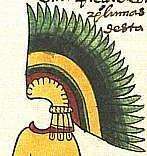Tlilpotoncatzin
Tlilpotonqui or Tlilpotoncatzin (died in the year 11 Reed/1503) was the second cihuacoatl ("president") of Mexico-Tenochtitlan.
| Tlilpotonqui | |
|---|---|
| 2nd Cihuacoatl of Mexico-Tenochtitlan | |
| 8 Reed (1487) – 11 Reed (1503) | |
| Tlatoani | Ahuitzotl Moctezuma II |
| Preceded by | Tlacaelel I |
| Succeeded by | Tlacaelel II |
| About | |
| Died |
|
| Father | Tlacaelel |
| Mother | Maquiztzin |
| Wives | Xiuhtoztzin Quauhtlamiyahualtzin |
| Children | 14 children |
Tlilpotoncatzin was the second son of Tlacaelel and Maquiztzin. His father was a son of the second tlatoani ("ruler" or "king") of Tenochtitlan, Huitzilihuitl. While Tlacaelel never became tlatoani himself, as cihuacoatl he played a significant role in the creation of the Aztec Empire. His mother was the daughter of Huehue Quetzalmacatzin, king of Itztlacozauhcan in Amaquemecan Chalco.[1] Tlilpotoncatzin succeeded his father as cihuacoatl upon his death in the year 8 Reed (1487).[2]

According to the Crónica mexicayotl of Fernando Alvarado Tezozomoc, composed around 1598, Tlilpotoncatzin was a great, brave warrior. In battle he wore the quetzalpatzactli, a crest of quetzal feathers.[3]
Tlilpotoncatzin took at least two wives, both from Amaquemecan: Xiuhtoztzin, the daughter of Yaopaintzin, quauhtlatoani of Tequanipan Huixtoco; and Quauhtlamiyahualtzin, a noblewoman from Acxotlan Cihuateopan.[4] He fathered fourteen children, eleven males and three females.[5] A son by Xiuhtoztzin, Miccacalcatl Tlatletecuintzin, was installed as the ruler of Tequanipan;[6] and one of his daughters, Tzihuacxochitzin II, married Moctezuma II, and gave birth to Leonor Moctezuma and María Moctezuma.[7]
Tlilpotoncatzin died in the year 11 Reed (1503).[8] He was succeeded by his nephew Tlacaelel II, the son of his elder brother Cacamatzin.[9]
Notes
- Chimalpahin (1997): vol. 1, pp. 49, 141–143.
- Chimalpahin (1997): vol. 1, p. 53; vol. 2, p. 35.
- Chimalpahin (1997): vol. 1, p. 145.
- Chimalpahin (1997): vol. 1., p. 153.
- Chimalpahin (1997): vol. 1, p. 143.
- Chimalpahin (1997): vol. 1, p. 157; vol. 2, p. 89.
- Chimalpahin (1997): vol. 1, pp. 55, 143, 163; vol. 2., p. 109.
- Chimalpahin (1997): vol. 1, p. 157; vol. 2, p. 37.
- Chimalpahin (1997): vol. 1, p. 55; vol. 2, p. 37.
References
- Chimalpahin Cuauhtlehuanitzin, Domingo Francisco de San Antón Muñón (1997). Codex Chimalpahin: society and politics in Mexico Tenochtitlan, Tlatelolco, Texcoco, Culhuacan, and other Nahua altepetl in central Mexico: the Nahuatl and Spanish annals and accounts collected and recorded by don Domingo de San Antón Muñón Chimalpahin Quauhtlehuanitzin. edited and translated by Arthur J. O. Anderson and Susan Schroeder. Norman: University of Oklahoma Press.
| Preceded by Tlacaelel I |
Cihuacoatl of Mexico-Tenochtitlan 1487–1503 |
Succeeded by Tlacaelel II |